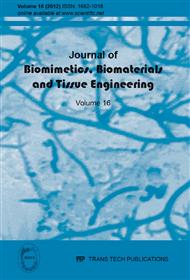[1]
Y. X Li, K. Xue. Mechanics in Leaf Venation Morphogenesis and their Biomimetic Inspiration to Construct a 2-Dimensional Reinforcement Layout Model. J. Biomim., Biomat., Tiss. Eng., 2011, 10, 81-93.
DOI: 10.4028/www.scientific.net/jbbte.10.81
Google Scholar
[2]
J. Chung, K. Lee. Optimal design of rib structures using the topology optimization technique. Proc. Instit. Mech. Eng. - Part C, J Mech. Eng. Sci., (1997), 211 (6), 425-37.
Google Scholar
[3]
L. A Krog, N. Olhoff. Optimum topology and reinforcement design of disk and plate structures with multiple stiffness and eigen frequency objectives. Computers and Structures, (1999), 72 (4-5), 535-63.
DOI: 10.1016/s0045-7949(98)00326-5
Google Scholar
[4]
Y. Couder, L. Pauchard, C. Allain, M. Adda Bedia, S. Douady. The leaf venation as formed in a tensorial field. Eur Phys J B (2002), 28 (2), 135-8.
DOI: 10.1140/epjb/e2002-00211-1
Google Scholar
[5]
F. Corson, M. Adda-Bedia, A. Boudaoud. In silico leaf venation networks: growth and reorganization driven by mechanical forces. J. Theor. Biol., (2009), 259 (3), 440-8.
DOI: 10.1016/j.jtbi.2009.05.002
Google Scholar
[6]
S. Bohn, B. Andreotti, S. Douady, J. Munzinger, Y. Couder. Constitutive property of the local organization of leaf venation networks. Phys Rev E, (2002), 65 (6 pt 1), 061914-061925.
DOI: 10.1103/physreve.65.061914
Google Scholar
[7]
C. Mattheck. Design in nature: Learning from trees. Berlin Heidelberg: Springer-Verlag, (1998).
Google Scholar
[8]
A. Samanta, M. Mukhopadhyay. Finite element static analysis of stiffened shells. Appl. Mech. Eng., (1998), 3 (1), 55–87.
Google Scholar
[9]
D. Nha Chu, Y. M Xie, A. Hira, G. P Steven. Evolutionary structural optimization for problems with stiffness constraints. Finite Elements in Analysis and Design, (1996), 21 (4), 239-51.
DOI: 10.1016/0168-874x(95)00043-s
Google Scholar
[10]
Q. Li, G. P Steven, Y. M Xie. Evolutionary structural optimization for stress minimization problems by discrete thickness design. Computers & Structures, (2000), 78 (6), 769-80.
DOI: 10.1016/s0045-7949(00)00057-2
Google Scholar
[11]
H. Kobayashi, M. Daimaruya, K. Kuribayashi. Venation pattern of butterbur leaf and its mechanical contribution. Journal Materials Science (2000), 49 (12), 1318-23.
DOI: 10.2472/jsms.49.1318
Google Scholar
[12]
Y. C Lam, S. Santhikumar. Automated Rib Location and Optimization for Plate Structures. Structural Multidisciplinary Optimization, (2003), 25 (1), 35-45.
DOI: 10.1007/s00158-002-0270-7
Google Scholar
[13]
D. Bojczuk, W. Szteleblak. Optimization of layout and shape of stiffeners in 2D structures. Computers and Structures, (2008), 86 (13-14), 1436-46.
DOI: 10.1016/j.compstruc.2007.05.005
Google Scholar


